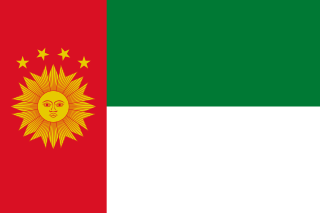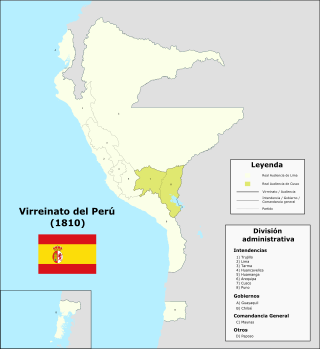
The Peru–Bolivian Confederation was a short-lived state that existed in South America between 1836 and 1839. The country was a loose confederation made up of three states: North Peru and South Peru—states that arose from the division of the Peruvian Republic due to the civil wars of 1834 and 1835 to 1836—as well as the Bolivian State.

The district of La Victoria is one of the forty-three districts that make up the province of Lima, located in Peru. It borders to the north and northeast with the district of Lima, to the east with the district of San Luis, to the southeast with the district of San Borja, to the south with the district of San Isidro, and to the west with the district of Lince and again with the Lima district. La Victoria is a historical and very busy public district located in downtown Lima. The current mayor of La Victoria is Rubén Dioscorides Andrés Cano Altez.

The Political Constitution of Peru is the supreme law of Peru. The current constitution, enacted on 31 December 1993, is Peru's fifth in the 20th century and replaced the 1979 Constitution. The Constitution was drafted by the Democratic Constituent Congress that was convened by President Alberto Fujimori during the Peruvian Constitutional Crisis of 1992 that followed his 1992 dissolution of Congress, was promulgated on 29 December 1993. A Democratic Constitutional Congress (CCD) was elected in 1992, and the final text was approved in a 1993 referendum. The Constitution was primarily created by Fujimori and supporters without the participation of any opposing entities.

The Republic of North Peru was one of the three constituent republics of the short-lived Peru–Bolivian Confederation of 1836–1839.

The Republic of South Peru was one of the three constituent Republics of the short-lived Peru–Bolivian Confederation of 1836–39.

Jorge Alfredo Basadre Grohmann was a Peruvian historian known for his extensive publications about the independent history of his country. He served during two different administrations as Minister of Education and was also director of the Peruvian National Library.

The Salaverry-Santa Cruz War, sometimes called the Peruvian Civil War of 1835–1836, was an internal conflict in Peru with the involvement of the Bolivian army of Andres de Santa Cruz. It ended with the defeat and execution of Felipe Santiago Salaverry and the creation of the Peru-Bolivian Confederation.

Jorge Vicente Martín Muñoz Wells is a Peruvian lawyer and politician who served as mayor of Lima from January 2019 until his removal from office by the National Jury of Elections in April 2022. He previously served as mayor of Miraflores from 2011 to 2018.

The Palacio de la Magdalena is a viceregal house located in the district of Pueblo Libre in Lima. It is located near the Plaza de los Libertadores, and is also known as the Quinta de los Libertadores. The building was declared a national monument in 1972.

The Monumental Museum of the District Municipality of Huanta, also known simply as the Huaura Balcony, is a war museum located in the Peruvian city of Huaura, dedicated to the memory of José de San Martín and the Liberating Expedition of Peru. The museum is housed in a Viceregal house that originally belonged to the Royal Customs of Lima. It was declared a historical monument by Law No. 9636 of October 28, 1942.

Peru–United Kingdom relations refers to the bilateral relations between the Republic of Peru and the United Kingdom of Great Britain and Northern Ireland. Relations between both countries date back to the British intervention in the Peruvian War of Independence.
The Provisional Regulations are the name given to an official document issued on February 12, 1821, by José de San Martín as Protector of Peru, considered the first legal document of the newly born state. The 20-article long document replaced the system of government established by the Spanish Empire, and applied to the territories occupied by the Liberating Army, which at the time were the province of Chancay—where San Martín's headquarters were set up in Huaura—and the intendancies of Tarma and Trujillo. These territories were organised in four departments, each headed by a president: Trujillo, Coast, Huaylas and Tarma.

The Intendancy of Lima, also known informally as Lima Province, was one of the territorial divisions of the Viceroyalty of Peru. The territory was ruled from the capital city of Lima. It was created in 1784 and lasted until 12 February 1821 when General Jose de San Martin created the Department of the Coast through the Reglamento Provisional to replace it in the new Republic of Peru.
The Department of the Coast was a short-lived department of the Protectorate of Peru that existed from 1821 to 1823. The department's lone leader, who held the title of President, was Vicente Dupuy.

The Department of Lima was a department of North Peru, a constituent country of the Peru–Bolivian Confederation, which existed from 1836 to 1839. Created alongside the confederate state, its capital was Lima.

The Intendancy of Tarma, also known informally as Tarma Province, was one of the territorial divisions of the Viceroyalty of Peru. The territory was ruled from Tarma. It existed from its creation in 1784 until it was replaced by the departments of Tarma and Huaylas on February 12, 1821.

The Department of Trujillo was a short-lived department of the Protectorate of Peru that existed from 1821 to 1825, when it renamed into the Department of La Libertad.

The War of Independence of Maynas, also known as the Maynas War, was an episode of the Spanish American Wars of Independence where the General Command of Maynas declared its independence from the Spanish Empire. It started with the royalist army's takeover of the city of Moyobamba in response to the city's imminent declaration of independence and ended with the capture of the city in 1822.

















